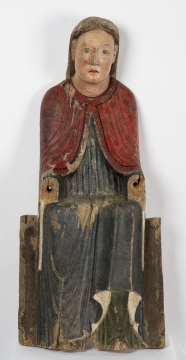The sculpture is one of the rare 10th century Sedes Sapientiae in Belgium not to have been subjected to drastic re-working during its existence.
Originally, the Virgin held the Child and a sceptre in her hands. The high back of the chair had been reduced, probably so that the statue could be placed in a niche or on an altar. As a result of these modifications, the work had taken on a more Gothic look. The folds of Mary’s robe create movement around the legs, and this helps soften the stasis of the torso. This style, inherited from the Byzantine period, was widespread in the 12th century for Mosan seated statues of the Virgin.
This work, made by an artist from the region, had been repainted several times over the centuries, thereby changing its interpretation considerably. The restoration of the statue was entrusted to the Institut Royal du Patrimoine Artistique. Stratigraphic and topographic study of the polychromes showed that originally the clothing was completely gilded although unfortunately only a few traces of this remained. The first re-painting, on the other hand, which can be dated to the 14th century, appeared to be particularly well preserved, although this layer was covered by the remains of other re-paintings (six layers in certain parts) and whitewashing that prevented all of the work’s finesse from being discerned. The face in particular, which had been covered by recent polychrome, had become especially inexpressive and coarse.
It was with an ophthalmic scalpel under a binocular microscope that the successive layers of polychrome were eliminated, right down to the first re-painting. Thanks to this delicate and lengthy operation, the Roman Virgin has regained all of her former highly coloured (red, blue and green) clothes, sprinkled with the gilded motifs. Her face has regained its finesse as well as the deep blue eyes that give it its expressiveness.
Since the climatological and security conditions were not completely optimal in its original location, the Church authority courageously took the decision to entrust the statue to the Musée Provincial des Arts Anciens du Namurois where it will be exhibited in the Salle du Trésor. However, the work will still be present in the Saint Laurent Church in Séron, thanks to an exact copy made of the statue after its restoration with all its polychrome.
